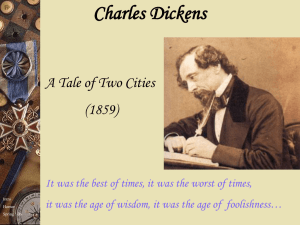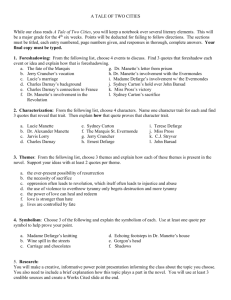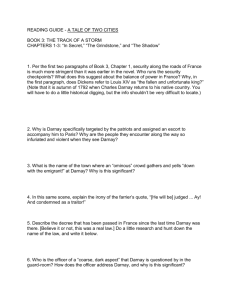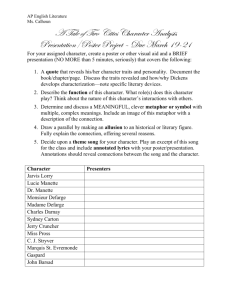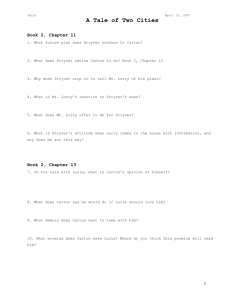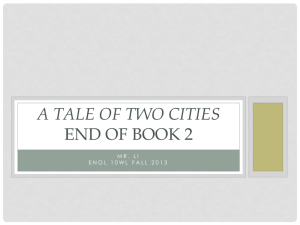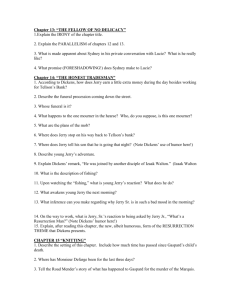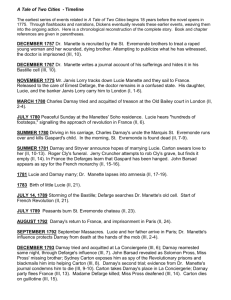A Tale of Two Cities
advertisement
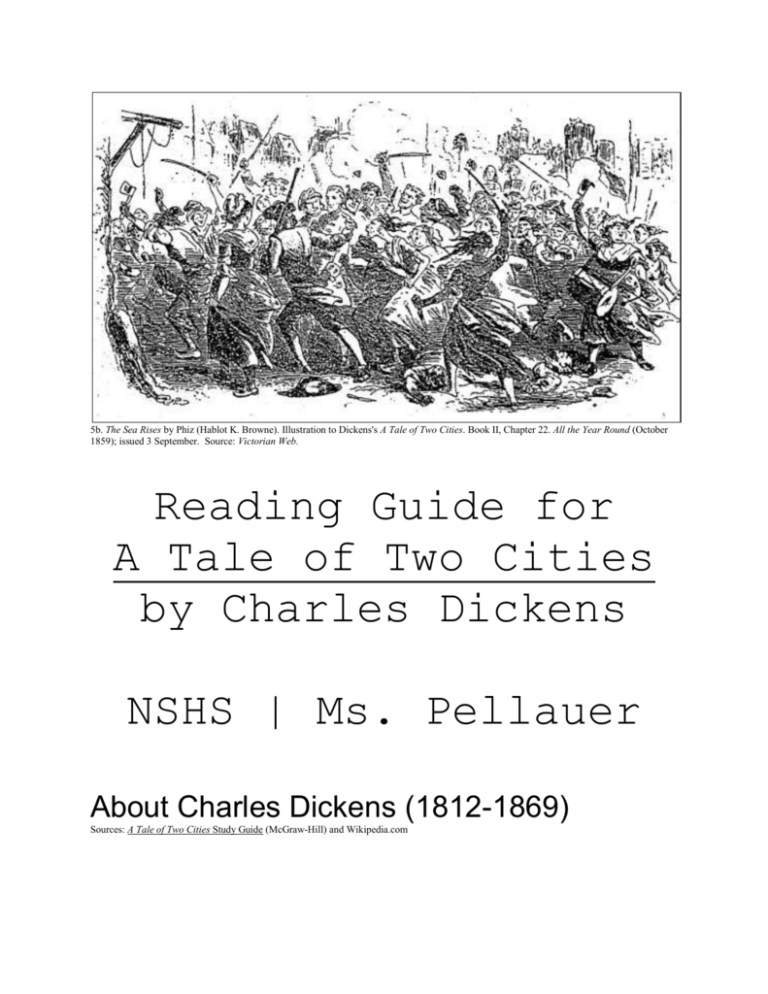
5b. The Sea Rises by Phiz (Hablot K. Browne). Illustration to Dickens's A Tale of Two Cities. Book II, Chapter 22. All the Year Round (October 1859); issued 3 September. Source: Victorian Web. Reading Guide for A Tale of Two Cities by Charles Dickens NSHS | Ms. Pellauer About Charles Dickens (1812-1869) Sources: A Tale of Two Cities Study Guide (McGraw-Hill) and Wikipedia.com 2 Document1 Childhood: Grew up lower middle class in London Forced to work at age 12 in a shoe polish factory when father went to jail for debt Worked as a law clerk at age 15 since father’s financial troubles prohibited schooling Family Life: Married and had 10 children with Catherine Hogarth, though they later separated in 1858 Career and Legacy: Published 15 novels, 5 novellas, innumerable short stories, and edited weekly periodicals Advocated on behalf of the poor and disenfranchised (usually women and children) “Charles Dickens” by Herbert Watkins, 1858 Source: National Portrait Gallery AToTC: Publication (1859) Manuscript from A Tale of Two Cities, 1859 Source: Victoria & Albert Museum and David Perdue’s Charles Dickens Page Published simultaneously in weekly parts (April 30 – November 26) and monthly parts (June – December) throughout 1859 in the periodical All the Year Round, a literary magazine founded by Dickens AToTC: Setting Source: David Perdue’s Charles Dickens Page 3 Document1 Story takes place before and during the French Revolution (1757-1794) AToTC: Characters (Sources of flags: CIA.gov) 4 Document1 Sydney Carton: An alcoholic, slightly pathetic ne’er-do-well who clerks for the pompous lawyer Mr. Stryver Charles Darnay: All around good guy who renounces French aristocratic background and moves to England Lucie Manette: Virgin Goddess Angel Queen (you’ll see what I mean) Doctor Manette: Father to Lucie, but a broken man with a troubled past Jarvis Lorry: A “man of business” who looks out for the Manettes’ welfare Jerry Cruncher: Lorry’s odd-job man at Tellson’s Bank who has suspicious extracurricular activities Miss Pross: The VGAQ’s nurse, servant, and fierce protector Ernest Defarge: Wine shop owner and revolutionary Madame Defarge: Wife of Ernest Defarge, ambitious knitter, and keeper of a bitter secret that explains her rancor towards the aristocracy Marquis St. Evrémonde: A cruel, heartless, and misanthropic aristocrat The Vengeance, the Jacques: Revolutionaries Unit Overview 5 Document1 Essential Questions How does social turmoil engender personal transformation (for better or worse)? What societal structures perpetuate a system of economic inequality? William Faulkner said, “The past isn’t dead; it isn’t even past.” How does that concept inform Tale and its characters? Source: Cartoon by J.B. Handelsman (1987, The New Yorker) This Unit Will Help You... Understand the high expectations for the literary analysis that we will do together all year Learn the language of tone analysis so that you can accurately and articulately explain an author’s tone Acquire strategies for reading a difficult text Form the habit of asking and answering questions with textual evidence What You’ll Write A series of analytical paragraphs (“Analytical Paragraph Boot Camp”) A 4-6 page literary analysis paper Homework Read (take notes, write questions) Answer Mr. Golding’s study questions Complete “after reading” tasks in this packet Avoid SparkNotes, Shmoop, etc. Source: Raging Chicken Press AToTC: Book the First (“Recalled to Life”) | Chapter 1 6 Document1 1. What was the attitude of British and French nobility concerning the future of their rule? 2. In France, what was a common punishment for not kneeling to honor monks? 3. What was the crime situation in England at this time? [AFTER READING] Focus: Style Reread the following excerpt and mark up how Dickens uses repetition, parallelism, sentence length, figurative language, and opposites. It was the best of times, it was the worst of times, it was the age of wisdom, it was the age of foolishness, it was the epoch of belief, it was the epoch of incredulity, it was the season of Light, it was the season of Darkness, it was the spring of hope, it was the winter of despair, we had everything before us, we had nothing before us, we were all going direct to Heaven, we were all going direct the other way – in short, the period was so far like the present period, that some of its noisiest authorities insisted on its being received, for good or for evil, in the superlative degree of comparison only. There were a king with a large jaw and a queen with a plain face, on the throne of England; there were a king with a large jaw and a queen with a fair face, on the throne of France. In both countries it was clearer than crystal to the lords of the State preserves of loaves and fishes, that things in general were settled for ever. It was the year of Our Lord one thousand seven hundred and seventyfive. So What?: Why might Dickens use these stylistic techniques? AToTC: Book the First (“Recalled to Life”) | Chapter 2 Document1 4. How did passengers on the Dover mail interact with each other? Why did they act this way? 5. What was the guard’s initial reaction to the arrival of Jerry Cruncher? 6. Who is Cruncher’s message for, and what is this gentleman’s occupation? 7. What was Cruncher’s message, and what was the reply? What do you think these messages mean? [AFTER READING] Focus: Introduction to Tone One convenient way of analyzing tone [the author’s attitude towards a subject] is to remember DIDLS: Diction, Imagery, Details, Language, and Syntax. Reread the first four paragraphs of Chapter 2, and record below especially evocative words and images used. 7 8 Document1 What words appear to have been chosen specifically for their effects? What effect do these words have on your mood as the reader What images are especially vivid? To what sense do these appeal? What effect do these images have on your mood as a reader? D Diction I Imagery So What?: How does the narrator feel towards the Dover mail? AToTC: Book the First (“Recalled to Life”) | Chapters 3-4 Book 1, Chapter 3 8. What is Cruncher’s reaction to the message he is to take to Tellson’s? 9. What question does Mr. Lorry ask the spectre? What is the spectre’s answer? What do you think this means? Book 1, Chapter 4 10. Describe Mr. Jarvis Lorry’s dress and physical appearance. 11. Who is Mr. Lorry waiting for in Dover? 12. Have Mr. Lorry and the young Lady met before? If so, when and under what circumstances? 13. What news does Mr. Lorry have for the young Lady? 14. What is her reaction to the news? [AFTER READING] Focus: Tone | What is the narrator’s tone towards _________? Choose 1 of the following characters (Jerry, Miss Manette, Mr. Lorry) and fill out at least 3 rows of DIDLS chart to figure out the narrator’s tone towards that character. 9 Document1 D Diction I Imagery Which details has the author included? Omitted? How would you describe the language? Scholarly? Slang? Are the sentences simple? Complex? D Details L Language S Syntax AToTC: Book the First (“Recalled to Life”) | Chapters 5-6 Book 1, Chapter 5 15. What are the people’s reactions to the broken wine cask? 16. The spilled wine is a symbol of what? 17. What is the power that has ground the people down? What does this tell us about conditions in France? 18. Describe Defarge and his wife. 19. Why do the men in the wine shop refer to each other as Jacques? (Look up the word “jacquerie.”) 20. Why have Mr. Lorry and Miss Manette come to Defarge’s wine shop? Why was Defarge chosen for this duty? 21. Why do you think Defarge shows Dr. Manette to the Jacques? Book 1, Chapter 6 22. What is Dr. Manette doing when they enter the room? 23. Describe the Doctor’s physical appearance. What does this say about his prison experience? 24. What physical characteristic tells us that Lucie is indeed the Doctor’s daughter? 25. When the doctor compares the strands of golden hair in his “locket” to Lucie’s hair, what is his first conclusion? Does he finally figure out the truth? [AFTER READING] Focus: Tone | What is the tone towards Defarge and his wife? 10 Document1 Fill out all rows of DIDLS chart. D Diction I Imagery Which details has the author included? Omitted? How would you describe the language? Scholarly? Slang? Are the sentences simple? Complex? D Details L Language S Syntax 11 Document1 AToTC: Book the Second (“The Golden Thread”) | Chapters 1-3 Book 2, Chapter 1 26. Describe Tellson’s bank. What is the bank’s attitude toward change? 27. How does Tellson’s treat the young men in its employ? 28. What behavior of Mrs. Cruncher makes Mr. Cruncher angry? Why does this anger him? 29. What physical characteristic of his father’s does young Jerry wonder about? Can you make a guess about it? Book 2, Chapter 2 30. What does Mr. Cruncher think is “Barbarous”? Do you agree or disagree with him? Why? 31. What is the “old Bailey” and what is it famous for? 32. Who is being tried, and what is the charge against him? 33. Who is present in the courtroom to act as witnesses for the prosecution? Book 2, Chapter 3 34. Where did Mr. Lorry, Miss Manette, and Dr. Manette first meet Charles Darnay? What was Lucie’s opinion of him? 35. What did the wigged gentleman who was looking at the ceiling point out to the counsel, Mr. Stryver, on the piece of paper that he threw to him? 36. What does Mr. Stryver say about Mr. Barsad and Mr. Cly? 37. What happens in the courtroom to prove that Mr. Carton is much more observant than his manner lets on? 38. What personal service does Carton do for Charles Darnay? What do you think this hints at for the future? 39. What is the verdict? [AFTER READING] Focus: Close Reading of the Blue Flies “Bluebottle fly adults feed on nectar, while the larvae feed on carcasses of dead animals” (image and text from Wikipedia.com) Fill in the chart with quoted evidence of the blue flies Quoted Evidence of the Blue Flies So What?: What’s the Point of the Evidence? What’s the role of the blue flies in this chapter? 12 Document1 AToTC: Book the Second (“The Golden Thread”) | Chapters 4-6 Book 2, Chapter 4 40. What do you think Carton and Darnay’s toast foreshadows? 41. What is Sydney Carton’s opinion of himself? Book 2, Chapter 5 42. What is Carton’s job? 43. Describe his working routine. Include when, where, and how. 44. After reading this chapter, describe Sydney Carton’s life and tell how you think he feels about it. Book 2, Chapter 6 45. Where does Mr. Lorry go most Sundays? Why? 46. What kind of housekeeper is Lucie? 47. Describe Miss Pross as she appears on the surface and how she really is once you get to know her. 48. How does Miss Pross describe the Doctor’s mental condition? What does it take to soothe him? 49. Who are the “hundreds of people” that visit the Manettes' on Sundays? [AFTER READING] Focus: Close Reading of the Echoing Footsteps In 2.6, Darnay, Lucie, and Carton sit together and comment on the “echoes of footsteps coming and going” (106). Compare in the chart below the different ways that the characters react to the footsteps that they hear. How does each character react? Darnay Lucie Carton Textual evidence of that reaction What does this reaction reveal about the character? Document1 13 AToTC: Book the Second (“The Golden Thread”) | Chapters 7-9 Book 2, Chapter 7 50. What kinds of people associate themselves with the Monseigneur? What does this say about what it takes to get ahead in France at this time? 51. Describe the “accident” that befalls the Monsieur the Marquis in the streets of Paris. 52. What is the Marquis’s attitude toward this “accident”? Book 2, Chapter 8 53. What are the conditions in the Marquis’s home village? 54. What unusual sight did the roadmender see? What prediction can you make from this? 55. Who is the Marquis expecting? Can you guess the identity of this person? Book 2, Chapter 9 56. Of what does Darnay accuse his uncle? 57. What is the Marquis’s philosophy of keeping the common people under control? 58. What is Darnay’s opinion of his family’s behavior and what does he plan to do about it? 59. What happens to the Marquis, and what does the note tell us? [BEFORE READING]: Distinguishing Monseigneur vs. Marquis vs. Monsieur (courtesy of our helpful friends at Stanford: http://dickens.stanford.edu/tale/print_issue5_gloss.html) 2.7: Monsieur the Marquis in Town “Monseigneur,” which means literally “My Lord” (Sanders 79), is an honorific title for a person of eminence – originally (in the medieval period) an honorific title for a saint, but afterwards attaching generally to a person of elevated condition. Here, the use of the title “Monseigneur” (to the exclusion of any further identification) indicates that the gentleman discussed is not only aristocratic, but superior to the Marquis (who is a mere “monsieur”) (OED). The French “Monsieur,” essentially equivalent to “Mr.” in English, was originally a title reserved for men of elevated station (Oxford English Dictionary). “Marquis” is an aristocratic title originally accorded to those who ruled the “marches” of a country (marches are border or boundary territories), and subsequently to any noblemen “ranking below a duke and above a count” (OED). In Dickens’ own time and country, a marquis ranked below a duke and above an earl (an earl being the English equivalent of a count); the equivalent female rank, in English, was marchioness (Philp 6). ***For our purposes in class, the main character to focus on is Monsieur the Marquis. 2.8: Monsieur the Marquis in the Country The peasants refer to Monsieur the Marquis as “Monseigneur,” but this is a sign of respect only. The chocolate-obsessed Monseigneur is not anywhere in this chapter. Document1 14 AToTC: Book the Second (“The Golden Thread”) | Chapters 10-13 Book 2, Chapter 10 60. A year after his uncle’s death, describe Charles Darnay’s professional and personal condition. 61. In proclaiming his love for Lucie, how does Charles show consideration for Dr. Manette? 62. What are the two promises that the Doctor makes Charles? 63. What is the effect on the Doctor of making these promises? Why do you think they had this effect on him? Book 2, Chapter 11 64. What future plan does Stryver confess to Carton? 65. What does Stryver advise Carton to do? Book 2, Chapter 12 66. Why does Stryver stop in to tell Mr. Lorry of his plans? 67. What is Mr. Lorry’s reaction to Stryver’s news? 68. What does Mr. Lorry offer to do for Stryver? 69. What is Stryver’s attitude when Lorry comes to the house with information, and why does he act this way? Book 2, Chapter 13 70. In his talk with Lucie, what is Carton’s opinion of himself? 71. What does Carton say he would do if Lucie should love him? 72. What memory does Carton want to take with him? 73. What promise does Carton make Lucie? Where do you think this promise will lead him? [AFTER READING] Focus: Close Reading of Chapter Titles 2.12 is titled “The Fellow of Delicacy” while 2.13 is called “The Fellow of No Delicacy.” Who is which fellow, and how does Dickens use these titles ironically? Explain in the space below. ______________________________________________________________________ ______________________________________________________________________ ______________________________________________________________________ ______________________________________________________________________ ______________________________________________________________________ ______________________________________________________________________ ______________________________________________________________________ ______________________________________________________________________ Document1 15 AToTC: Book the Second (“The Golden Thread”) | Chapters 14-15 Before doing tonight’s reading, make sure you can explain the following events from Chapters 1-13 by completing each statement below: Darnay is on trial because… Darnay is found innocent because… Dr. Manette turns pale in the garden because… The Marquis’s trip to the country is interrupted because… The mender of roads stares at the Marquis’s carriage because… Two places are set for dinner at the Marquis’s chateau because… Another “stone face” is added to the chateau because… Lorry must dissuade Stryver from proposing to Lucie because… Darnay does not tell Dr. Manette his real name because… Carton admires and loves Lucie because… Book 2, Chapter 14 74. Whose funeral procession does the crowd attack? Why do they attack it? 75. What is Jerry Cruncher’s reaction to the mob violence? 76. Describe Mr. Cruncher’s “fishing tackle.” What kind of “fish” do you think he is going for with this type of “tackle”? 77. What name does young Jerry give to his father’s “trade,” and what is Mr. Cruncher’s response when young Jerry says he wants to be in that trade when he grows up? Do you see an irony in “resurrection man” and “recalled to life”? Book 2, Chapter 15 78. What was the fate of the Marquis’s killer, and who reported that fate to Defarge? 79. What is the sentence that Defarge and his compatriots give after hearing the fate of the Marquis’s killer? What are the future implications of this sentence? 80. How are these sentences recorded so that they will be kept secret until the appropriate time? 81. Why does Defarge compliment his guest for cheering the king and queen? [AFTER READING] Focus: Dickens’s Foreshadowing Now that you know Jerry Cruncher is a “resurrection man” (a.k.a. grave digger), go back to 2.1 (“Five Years Later”) and list all of the details in the space below from that chapter where Dickens foreshadows Cruncher’s nighttime hobby. 16 Document1 AToTC: Book the Second (“The Golden Thread”) | Chapters 16-18 Book 2, Chapter 16 82. What information does Defarge get from Jacques on the police force? Where have you heard of this man before? 83. Why is Defarge depressed, and how does Madame Defarge comfort him? 84. What is the significance of Madame Defarge pinning a rose in her hair? 85. What does the spy learn from the Defarges, and what do they learn from him? Why does the spy’s information disturb the Defarges? Book 2, Chapter 17 86. What are the Doctor’s feelings about Lucie’s impending marriage? Book 2, Chapter 18 87. What does Charles Darnay tell the Doctor on the morning of his marriage to Lucie? 88. What is the Doctor’s response to the combination of this information and the giving of his daughter in marriage? 89. What two things does Mr. Lorry do in reaction to the Doctor’s condition? [AFTER READING] Focus: Characterization of the Defarges Read the evidence below from 2.16 (“Still Knitting”), and write a thesis statement that the evidence would prove Madame Defarge “where Madame Defarge immediately took her post at her desk, counted the small moneys…, examined the stock, went through the entries in the book, made other entries of her own, checked the serving man in every possible way, and finally dismissed him to bed” (184) Madame’s actions: Monsieur Defarge “Defarge, with his pipe in his mouth, walked up and down, complacently admiring, but never interfering; in which condition, indeed, as to the business and his domestic affairs, he walked up and down through life” (184) -“raising her glance as she knotted the money” (184) -“tied a knot with flashing eyes, as if it throttled a foe” (185) -“tying another knot, as if there were another enemy strangled” (185) -“tied a very terrible knot indeed” (186) -“Madame enforced the conclusion of his piece of advice by striking her little counter with her chain of money as if she knocked its brains out…” (186) -acknowledged -began -said…”as if a thought were wrung out of his breast” (185) -said -“raised his forehead thoughtfully” (185) -said -returned -“standing before her with his head a little bent, and his hands clasped at his back, like a docile and attentive pupil before his catechist” (185) Thesis: Monsieur’s actions: 17 Document1 AToTC: Book the Second (“The Golden Thread”) | Chapters 19-21 Book 2, Chapter 19 90. How does Mr. Lorry go about approaching the Doctor about his condition without upsetting him? 91. What is the Doctor’s opinion about the future of Mr. Lorry’s “hypothetical” man? 92. What one thing does the Doctor say that could bring on another relapse? What does he mean? 93. What does Mr. Lorry recommend to the Doctor, and how does he talk him into following it? Book 2, Chapter 20 94. What request does Carton make of Charles? 95. What does Lucie request of Charles? Book 2, Chapter 21 96. What is the significance of the “echoing footsteps”? 97. What sad thing befell Charles and Lucie during this time period? 98. What has happened to Carton and Stryver over the years? 99. What happened in Paris on July 14, 1789? 100. Where did Defarge demand to be taken first? Why? 101. How does Madame Defarge show her merciless strength? [AFTER READING] Focus: Tone | What is the tone towards Lorry and Pross’ action at the end of Chapter 19? Fill out all rows of DIDLS chart. D Diction I Imagery D Which details has the author included? Omitted? How would you describe the language? Scholarly? Slang? Are the sentences simple? Complex? Details L Language S Syntax 18 Document1 AToTC: Book the Second (“The Golden Thread”) | Chapters 22-24 Book 2, Chapter 22 102. Who is Madame Defarge’s lieutenant in leading the women, and what does this “nickname” imply about her? 103. Who was Old Foulon and what was his fate? 104. What has begun? Book 2, Chapter 23 105. What is the symbol of the revolutionaries? 106. What happens at the Marquis’s villa? What is this an example of? Book 2, Chapter 24 107. In the year 1792, where was the headquarters for the “Monseigneur” in London? 108. Why is Mr. Lorry going to France? What is his mission? 109. What is Gabelle’s urgent plea? 110. What is Charles’s decision? Why does he decide on this course of action? What does this say about his character? [AFTER READING] Focus: Close Reading of the Mob Scenes Use the chart below to compare Dickens’s characterization of the English mob in Chapter 14 with the French mob in Chapters 21-22. The English Mob The French Mob So What?: What do these descriptions allow you to conclude? Document1 19 AToTC: Book the Third (“The Track of a Storm”) | Chapters 1-3 Book 3, Chapter 1 111. What type of reception does Charles receive in France? 112. What is the “emigrant decree,” and how does it affect Charles? 113. What is Defarge’s reaction to Charles’s plea for help, and why does he act this way? 114. Who is this La Guillotine who has become the new darling of France? 115. Why is Charles’s detention worse than general imprisonment? Book 3, Chapter 2 116. What horrible thing is located in the courtyard of Tellson’s in Paris? What makes it horrible? 117. Who are Mr. Lorry’s surprise guests, and what news do they bring him? 118. Why does the Doctor say he leads a “charmed life” in Paris? 119. What is the mob’s reaction to the Doctor’s plea for help? Book 3, Chapter 3 120. Who is the messenger that comes to Mr. Lorry, and what is his message? 121. Why does Madame Defarge say she visits Lucie, and what is her true reason? 122. What does Lucie ask of Madame Defarge, and how does she respond? [AFTER READING] Focus: Close Reading of Charles Darnay’s Mental State Annotate this excerpt from 3.1 for notable repetition, diction, and figurative lang. “Five paces by four and a half, five paces by four and a half, five paces by four and a half.” The prisoner walked to and fro in his cell, counting its measurement, and the roar of the city arose like muffled drums with a wild swell of voices added to them. “He made shoes, he made shoes, he made shoes.” The prisoner counted the measurement again, and paced faster, to draw his mind with him from that latter repetition. “The ghosts that vanished when the wicket closed. There was one among them, the appearance of a lady dressed in black, who was leaning in the embrasure of a window, and she had a light shining upon her golden hair, and she looked like * * * * Let us ride on again, for God’s sake, through the illuminated villages with the people all awake! * * * * He made shoes, he made shoes, he made shoes. * * * * Five paces by four and a half.” With such scraps tossing and rolling upward from the depths of his mind, the prisoner walked faster and faster, obstinately counting and counting; and the roar of the city changed to this extent—that it still rolled in like muffled drums, but with the wail of voices that he knew, in the swell that rose above them. Document1 20 AToTC: Book the Third (“The Track of a Storm”) | Chapters 4-7 Book 3, Chapter 4 123. What conditions does the Doctor find in the prison? 124. What has the eighteen years he spent in prison done for the Doctor? 125. What position did the Doctor achieve because of his status, and how does this position help Charles? 126. What is the new legal order in France at this time? Book 3, Chapter 5 127. How does Lucie respond to living fifteen months in constant fear that every day might be Charles’s last? What does this say about her? 128. What small scrap of good news does the Doctor bring Lucie? 129. Who is the wood-sawyer, and what is his attitude toward those in prison? 130. What is the Carmagnole, and why does Lucie think it is terrible? Book 3, Chapter 6 131. Who orchestrates Charles’s acquittal, and is his defense built on fact or emotion? 132. What is the mob’s reaction to Charles’s acquittal, and why is this surprising? Book 3, Chapter 7 133. Why do Charles and his family stay in France, and what is their style of living there? 134. What happens to Charles during his first night of freedom? [AFTER READING] Focus: Characterization of the Guillotine Answer the following question with 2 pieces of evidence: How does Dickens characterize the guillotine, and to what effect? ______________________________________________________________________ ______________________________________________________________________ ______________________________________________________________________ ______________________________________________________________________ ______________________________________________________________________ ______________________________________________________________________ ______________________________________________________________________ ______________________________________________________________________ ______________________________________________________________________ ______________________________________________________________________ ______________________________________________________________________ Document1 21 AToTC: Book the Third (“The Track of a Storm”) | Chapters 8-9 Book 3, Chapter 8 135. Who do Miss Pross and Jerry Cruncher run into while shopping? 136. Who does Carton know this man as? 137. How does Carton get this man to help him? 138. What startling information does Mr. Cruncher have concerning the death of Roger Cly, and how does this information help Carton? Book 3, Chapter 9 139. What is Barsad going to do for Carton? What do you think Carton’s plan is? 140. What memory gives Carton comfort as he wanders the Paris streets, and what does it tell us of why he turned out the way he did? 141. Who are Charles’s accusers? Why is one of them particularly surprising? 142. What is the form of Dr. Manette’s accusation? [AFTER READING] Focus: Dickens’s (In)Consistency? “When he awoke and was afoot again, he lingered there yet a little longer, watching an eddy that turned and turned purposeless, until the stream absorbed it, and carried it on to the sea. – ‘Like me!’” (327) This passage assures the reader of Carton’s future transformation from “purposeless” eddy to integral part of “the sea,” a change that Dickens undoubtedly views as positive. And yet, his use of water imagery evokes his earlier critical descriptions of mob violence: weren’t these individual citizens also “purposeless” until “the stream” of revolution spurred them to act? Is Dickens being inconsistent? According to Dickens, when is it acceptable – even commendable – to be “carried…on to the sea” and when is it deplorable? Use at least 1 piece of evidence. ______________________________________________________________________ ______________________________________________________________________ ______________________________________________________________________ ______________________________________________________________________ ______________________________________________________________________ ______________________________________________________________________ ______________________________________________________________________ ______________________________________________________________________ ______________________________________________________________________ 22 Document1 AToTC: Book the Third (“The Track of a Storm”) | Chapters 10-12 Book 3, Chapter 10 143. Who are the twin brothers who need the Doctor’s services? 144. Who is the sick woman, and what is wrong with her? 145. What does this say about the brothers’ character? 146. What was the boy’s last act, and how has it turned out? 147. What was the Marquis St. Evrémonde’s wife’s request of the Doctor? Whose mother was she? 148. Who had the Doctor put in prison and why? 149. What was the last thing the Doctor wrote in his account, and what effect does its reading have? Book 3, Chapter 11 150. Why didn’t Lucie collapse when Charles was condemned, and what does this say about her? 151. Why did Carton encourage Dr. Manette to continue his efforts to free Charles? What does this say about Carton? Book 3, Chapter 12 152. Why did Carton go to Defarge’s wine shop? 153. What are Madame Defarge and Defarge arguing over? 154. Why is Madame Defarge so merciless towards Charles and his family? 155. What is the Doctor’s condition when he returns, and what is its cause? 156. What papers does Carton give Mr. Lorry to hold? 157. Why does Carton instruct Lorry to be prepared to leave the next day? What do you think is Carton’s plan? [AFTER READING] Focus: Characterization of Carton Provide evidence of Carton’s transformation in the chart below The “Before” Carton (2.4, 2.5, 2.13) So What?: The “After” Carton (Book 3) Explain whether you think Carton’s transformation is legitimate. Document1 AToTC: Book the Third (“The Track of a Storm”) | Chapters 13-end Book 3, Chapter 13 158. What does Charles write in his “last” letter? 159. How does Carton get Charles to go along with his plan? 160. How does Carton get Charles out of prison? 161. How is Carton going to keep the promise he made to Lucie years before? Book 3, Chapter 14 162. What is Madame Defarge’s plan and what does Defarge think of it? 163. What plan are Miss Pross and Mr. Cruncher following and why? 164. What happens between Miss Pross and Madame Defarge? Book 3, Chapter 15 165. At the execution, what do they say about Carton? 166. What does Carton foretell for Charles and Lucie, and how does their future bring honor to his name? [AFTER READING] Focus: Theme Now that you have finished the novel, brainstorm 3-5 theme statements. In A Tale of Two Cities, Charles Dickens suggests that… 1. 2. 3. 4. 5. 23
